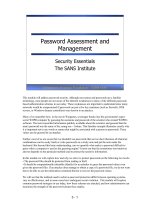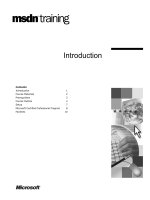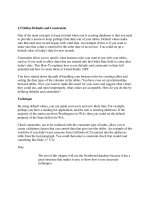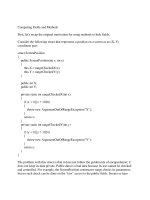Tài liệu Organizational Improvement and Accountability ppt
Bạn đang xem bản rút gọn của tài liệu. Xem và tải ngay bản đầy đủ của tài liệu tại đây (1.24 MB, 154 trang )
Prepared for
The William and Flora Hewlett Foundation
ORGANIZATIONAL
IMPROVEMENT
AND
ACCOUNTABILITY
LESSONS FOR EDUCATION FROM OTHER SECTORS
Brian Stecher and Sheila Nataraj Kirby
EDITORS
The RAND Corporation is a nonprofit research organization providing
objective analysis and effective solutions that address the challenges
facing the public and private sectors around the world. RAND’s
publications do not necessarily reflect the opinions of its research clients
and sponsors.
R
®
is a registered trademark.
© Copyright 2004 RAND Corporation
All rights reserved. No part of this book may be reproduced in any form
by any electronic or mechanical means (including photocopying,
recording, or information storage and retrieval) without permission in
writing from RAND.
Published 2004 by the RAND Corporation
1700 Main Street, P.O. Box 2138, Santa Monica, CA 90407-2138
1200 South Hayes Street, Arlington, VA 22202-5050
201 North Craig Street, Suite 202, Pittsburgh, PA 15213-1516
RAND URL: />To order RAND documents or to obtain additional information, contact
Distribution Services: Telephone: (310) 451-7002;
Fax: (310) 451-6915; Email:
Library of Congress Cataloging-in-Publication Data
Organizational improvement and accountability : lessons for education from other sectors
/ Brian Stecher [et al.].
p. cm.
“MG-136.”
Includes bibliographical references.
ISBN 0-8330-3500-2 (paperback)
1. Educational accountability—United States. 2. School management and
organization—United States. 3. Organizational effectiveness—Evaluation. I. Stecher,
Brian M. II. Rand Corporation.
LB2806.22.O74 2004
379.1'58—dc22
2003024743
Cover design by Peter Soriano
The research described in this report was prepared for The William and
Flora Hewlett Foundation by RAND Education.
iii
Preface
Educational accountability became the law of the land with the pas-
sage of the No Child Left Behind Act of 2001. As states rushed to
develop accountability systems that met the requirements of the new
law, the Hewlett Foundation asked RAND Education to undertake
two tasks. The first was to write a paper that delineated carefully the
provisions of the new law and the underlying assumptions on which
the new test-based accountability systems are based, and to dissemi-
nate it broadly to experts and practitioners. With help from a group
of experts who participated in an Accountability Forum held at
RAND in 2002, we produced a RAND Corporation White Paper,
Working Smarter to Leave No Child Behind: Practical Insights for
School Leaders (Stecher, Hamilton, and Gonzalez, 2003).
The second task we undertook was to examine models of ac-
countability in sectors other than education. The goal of the investi-
gation was to understand how such models work and their applica-
bility to education. This monograph documents the results of that
examination. It should be of interest to educational policymakers,
educational administrators, and others who are interested in improv-
ing the effectiveness of schools. The work was sponsored by the Wil-
liam and Flora Hewlett Foundation.
v
Contents
Preface iii
Figure and Tables xi
Summary xiii
Acknowledgments xix
CHAPTER ONE
Introduction 1
Accountability in Education 1
Other Approaches to Educational Accountability 4
Accountability in Other Sectors 7
Organization of the Monograph 9
CHAPTER TWO
Malcolm Baldrige National Quality Award Program 11
Background 12
The Baldrige Criteria for Performance Excellence 14
Education Criteria for Performance Excellence 16
Organizational Performance Results 17
Strategic Planning 18
Information and Analysis 18
Process Management 19
Evidence on the Baldrige Framework: Effects on Performance 19
Validating the Framework 20
Effect on Operating Performance 21
The K–12 Educational Sector Experience with the MBNQA 25
vi Lessons for Education from Other Sectors
Winners of the Baldrige Award in Education 25
Chugach School District (CSD), Alaska 26
Pearl River School District (PRSD), New York 27
Other Users of the Baldrige Criteria 28
Implications for Education 29
Institutional Self-Assessment May Be Inherently Beneficial 29
The Baldrige Process Supports Accountability 30
Educators May Find It Difficult to Understand and Translate the
Criteria 31
Some Caveats 32
CHAPTER THREE
Toyota Production System/Lean Manufacturing 35
Overview of TPS/Lean Manufacturing 35
Focus on the Value Stream 37
Standardization 38
Worker Empowerment 39
Evidence for Effects of TPS/Lean Manufacturing on Production and
Workers 40
Worker Empowerment or Worker Exploitation? 42
Applying TPS/Lean Manufacturing to Education 43
Implications for Education 45
Greater Focus on Value Streams Could Improve Educational
Outcomes 45
Teaching Practices May Benefit from Standardization 47
Worker Empowerment Could Improve Educational Practices 48
TPS/Lean Production Must Be Used as a Complete System 49
Closely Translating TPS Practices to Education Is Challenging 49
CHAPTER FOUR
The Job Training Partnership Act and the Workforce
Investment Act 51
Overview of the Job Training Partnership Act 51
Performance Standards 52
Performance Incentives 53
How JTPA Worked in Practice 54
Contents vii
Measures of Performance 54
Effects on Provider Behavior 55
Overview of the Workforce Investment Act 57
Early Implementation of the WIA 58
Implications for Education 59
Explicit Performance Objectives May Produce Mixed Outcomes 59
Data Collection Alone Does Not Drive Improvement 61
Educational Systems Should Use Multiple Measures
of Performance 61
The JTPA Framework Highlights the Need to Adjust for
Differences in Ability 62
CHAPTER FIVE
Accountability in the Legal Profession 65
The Nature of Professions 65
Overview of Accountability in the Legal Profession 68
Professional Authority 68
Controls on Entry 69
Alternative Legal Training 71
Continuous Professional Development 72
Professional Responsibility 72
Addressing and Protecting Client Concerns 73
Collective Self-Regulation 74
Lawyer Discipline System 75
Market Forces 76
Applying the Legal Model to Educational Accountability 76
Implications for Education 79
The Knowledge Base in Education is Not Yet Sufficiently
Well-Regarded for Professional Accountability 79
Professional Accountability and Alternative Certification
Can Coexist 81
Educators Should Foster a Sense of Public Responsibility 81
Educators Would Need Methods of Self-Policing and
Self-Regulation 82
Professional Accountability Is Complemented by Market
Accountability 84
viii Lessons for Education from Other Sectors
CHAPTER SIX
Clinical Practice Guidelines in the Health Sector 85
Background 85
Health Care Guideline Development 86
Topic Selection 86
Identification of Decisionmaking Group 87
Gathering the Evidence 87
Decisionmaking Process 88
Dissemination of Guidelines 88
The Effect of Guidelines on Health Care Practices 89
Applying the Concept of Practice Guidelines to Education 89
Implications for Education 91
Practice Guidelines Could Address Variations in
Teaching Practices 91
Guideline Development Would Be Limited by the Lack of
Scientific Evidence 92
Educators Need a Common System of Classification to Develop
Guidelines 93
CHAPTER SEVEN
Risk Adjustment Methods in Health Care Accountability 95
Making Fair Comparisons 95
How Risk Adjustment Is Done 96
Limitations 98
Applying Risk Adjustment to Education 99
Current Uses of Risk Adjustment in Education 100
Implications for Education 103
Risk Adjustment in Education May Be Controversial 103
Risk Adjustment Requires Agreement About Outcomes
and Measures 103
Identifying Risk Factors Accurately Requires Extensive Data 104
Educators Should Understand and Accept the Risk-Adjustment
Model 104
CHAPTER EIGHT
Health Care Report Cards and the Public Release of Data 107
Contents ix
Facilitating Improvement by Means of Information 107
History of Health Care Report Cards and Public Release of Data 108
How Report Cards Have Affected the Health Care Industry 111
Health Care Organizations 111
Physicians and Clinicians 112
Consumers 112
Mixed Reactions to Health Care Data Reporting 113
Public Release of Data in Education 114
Implications for Education 115
Performance Report Cards Work Best with Competition 115
Publicizing Performance Data May Have Undesired
Consequences 115
CHAPTER NINE
Conclusions 117
Enhancing Effective Accountability in Education 119
Broaden Performance Measures 121
Make Sure Performance Goals Are Fair 121
Develop Standards of Practice in Promising Areas and Encourage
Professional Accountability 121
Develop an Integrated, Comprehensive Strategy to Help Schools
and Districts Improve Their Performance 122
Final Conclusions 124
References 125
xi
Figure and Tables
Figure
1.1. Elements of a Standards-Based Accountability Model 3
Tables
1.1. Overview of Key Features of Educational Accountability 5
9.1. Areas of Educational Accountability Where Non–Education
Sector Models Offer Guidance 118
xiii
Summary
Performance-Based Accountability in Education
In December 2001, the U.S. Congress approved a reauthorization of
the Elementary and Secondary Education Act (ESEA) and renamed it
the “No Child Left Behind Act” (P.L. 107-110, H.R. 1). The corner-
stone of the No Child Left Behind Act (NCLB) is a performance-
based accountability system built around student test results. This
increased emphasis on accountability represents an important change
from past federal educational initiatives, which focused primarily on
the provision of services. Supporters of NCLB argued that previous
educational reforms were unsuccessful in large measure because they
ignored student outcomes. Borrowing from successful private-sector
management practices, they made the case that student achievement
would only improve when educators were judged in terms of student
performance and consequences were attached to the results.
Three basic elements make up the performance-based account-
ability system required by NCLB: goals; assessments for measuring
the attainment of goals and judging success; and consequences (re-
wards or sanctions). The goals are embodied in a set of content or
performance standards that schools and teachers use to guide cur-
riculum and instruction. Tests are developed to measure student
learning and determine whether students have mastered the stan-
dards. Improved performance on the tests leads to rewards that are
intended to reinforce effective behavior; poor performance on the
tests leads to sanctions and improvement efforts that are intended to
xiv Lessons for Education from Other Sectors
modify ineffective behavior. Some of the incentives operate through
parents. If a child’s school is deemed to be in need of improvement,
parents can request a transfer to another school and/or supplemental
educational services from private providers.
As clear as these procedures may seem, the key principles un-
derlying NCLB accountability are largely untested in education. The
mechanisms through which the system is intended to work to im-
prove student achievement and eliminate failing schools are not well
understood. In this environment, decisionmakers at the state, district,
and school levels are looking for guidance to help them make their
systems as effective as possible. One place to look for possible insights
into effective accountability mechanisms is outside the educational
sector. The purpose of this project is to examine accountability in
other fields to find lessons that might be relevant for educators.
Accountability in Other Sectors
We cast our net widely before selecting specific instances of account-
ability to study. We solicited recommendations from educational re-
searchers as well as research colleagues who study organizations in
other fields. We also reviewed the debate within education sur-
rounding the passage of NCLB for references to accountability in
other domains. The final set of cases reflects our desire to present ex-
amples that are relevant, interesting, and diverse. Our sample includes
cases from both the manufacturing and service sectors. In each case,
we tried to understand the processes through which providers are
held accountable, how well these processes have worked, and whether
they might be applicable to education.
We examined five accountability models:
• Two accountability models drawn from the manufacturing sec-
tor (although now spreading to service industries): the Malcolm
Baldrige National Quality Award Program and the Toyota Pro-
duction System (TPS). Strictly speaking, these are models of
organizational improvement set within the larger context of
Summary xv
market accountability rather than full-fledged accountability sys-
tems. Both, however, offer ways to improve organizational effi-
ciency.
• A performance incentive model used in the evaluation of job
training programs for the poor established by the Job Training
Partnership Act (JTPA) of 1982 (now replaced by the
Workforce Investment Act (WIA) of 1998).
• Accountability in the legal sector. The legal accountability
model is largely based on notions of “professional accountabil-
ity,” which entail controlling entry into the profession, manda-
tory capacity-building, self-policing, and protecting client con-
cerns.
• Accountability in health care. We explored three aspects of
health care accountability that seemed particularly relevant for
education: clinical practice guidelines, use of statistical risk ad-
justment methods, and the public reporting of health perform-
ance measures.
These models differ in terms of their comprehensiveness, effec-
tiveness, and applicability to education. In this monograph, we de-
scribe each model, summarize the relevant research on effectiveness,
and draw specific lessons for educators.
Implications for Education
We recognize that the education sector has unique characteristics that
set it apart from the other sectors we examined. Yet we believe the
analyses of these different accountability models offer useful insights
on ways to enhance system-wide accountability in education, in-
cluding how to improve the operation of schools and districts to
achieve higher performance. Specific lessons learned for education
include the following:
Broaden performance measures. Educators should be careful when
setting performance objectives because the objectives will drive be-
havior—for better or for worse. Broadening “what counts” in the sys-
xvi Lessons for Education from Other Sectors
tem is one way to diffuse the pressure to focus too narrowly and to
deemphasize other important priorities.
Make sure performance goals are fair to all students and schools.
The accountability system should establish reasonable improvement
targets for all schools and should not reward or penalize schools or
districts for factors beyond their control. The goal of fair comparisons
also needs to be balanced against the goal of closing the gap between
successful and unsuccessful students. Nevertheless, the experiences of
JTPA/WIA and health point out the advantages of performance tar-
gets that are sensitive to initial inputs.
Develop standards of practice in promising areas and encourage
professional accountability. Movements to create more-explicit stan-
dards of practice would foster professional accountability and provide
guidance to help schools and districts improve their performance. We
encourage educators to select promising areas in which more-detailed
practice guidelines might be developed. Such guidelines can form the
basis for more-detailed standards for the teaching profession so teach-
ers can be more aggressive about monitoring their own professional
competence. These steps would help broaden and deepen account-
ability in education.
Develop an integrated, comprehensive strategy to help schools and
districts improve their performance. This research points to four key
elements of an improvement strategy:
• Undertaking a focused institutional self-assessment (including
asking the right questions and assembling the right kinds of in-
formation)
• Understanding the school system as a linked process
• Developing and applying an expanded knowledge base about ef-
fective practice in varying situations
• Empowering participants in the process (notably teachers) to
contribute to improvement efforts.
Developing and adopting such a strategy in education will re-
quire time, effort, and a willingness to adapt principles from outside
the educational sector. Pilot efforts to adapt and test these compo-
Summary xvii
nents in diverse schools settings and focused efforts to create educa-
tional applications would be a good starting place to try to take ad-
vantage of the successful experiences of other sectors.
In Conclusion
This investigation of accountability in other sectors sharpens our
thinking about accountability in education. It suggests ways in which
educators can develop better strategies for improving the performance
of schools and districts and policymakers can redefine educational
accountability to make it more effective. It is worth pointing out that,
although education has much in common with business, law, and
health care, it faces unique challenges that other sectors do not face.
Nevertheless, educators have much to learn from these other fields. In
the end, they will have to develop an accountability model that ad-
dresses their unique situation. However, there is much they can draw
on from accountability efforts outside of education.
xix
Acknowledgments
We are particularly grateful for the help we received from Jennifer Li,
who worked with us to make the presentations consistent across
chapters. We want to thank Cynthia Cook and Paul Shekelle for their
helpful reviews of the manuscript and their excellent suggestions of
additional sources of information. We also want to thank Jorge Ruiz-
de-Velasco, Marshall Smith, and the William and Flora Hewlett
Foundation for their patience and support as the task grew larger
than originally anticipated.
1
CHAPTER ONE
Introduction
Sheila Nataraj Kirby and Brian Stecher
Accountability in Education
Accountability in education refers to the practice of holding educa-
tional systems responsible for the quality of their products—students’
knowledge, skills, and behaviors. It is neither a new idea nor a new
practice. In fact, Kirst (1990), in his historical overview of educa-
tional accountability, points out that as far back as mid–19th century
England, schools were paid according to the performance of their
students on standardized examinations—“payment by results.” In
20th century America, public schools were held accountable through
a variety of regulatory mechanisms—school buildings had to meet
strict safety codes, teachers had to obtain formal certification, stu-
dents had to study from approved textbooks, and a cornucopia of
specific programs was mandated by state and federal governments.
Schools were required to comply with these rules to ensure that stu-
dents received an adequate education.
As the 21st century begins, educational accountability has taken
a different turn. In December 2001, the U.S. Congress approved a
reauthorization of the Elementary and Secondary Education Act
(ESEA) and renamed it the “No Child Left Behind Act” (P.L. 107-
110, H.R. 1). The cornerstone of the No Child Left Behind Act
(NCLB) is an emphasis on accountability based on student test re-
sults. Supporters of test-based accountability argue that previous re-
forms failed because they focused on inputs (e.g., facilities, teachers,
2 Lessons for Education from Other Sectors
textbooks) or on specific practices (e.g., remedial instruction, health
services, school lunch programs), but never on outcomes. Advocates
of NCLB further contend that educators have never been held re-
sponsible for student learning; instead teachers and administrators are
paid (i.e., rewarded) on the basis of their educational backgrounds
and their longevity in the profession. As a result, they feel no personal
or collective responsibility for how much students learn. Borrowing
from successful private-sector management practices, accountability
advocates believe that student achievement will improve only when
educators are judged in terms of student performance and experience
consequences as a result.
Although the No Child Left Behind act is hundreds of pages
long and the details of its implementation are quite complex, the
logic of its accountability system is quite simple. The accountability
system has three major components:
• Goals—explicit statements of desired student performance—to
convey clear and shared expectations for all parties
• Assessments for measuring attainment of goals and judging
success
• Consequences (rewards or sanctions) to motivate administrators,
teachers, and students to maximize effort and effectiveness.
Figure 1.1 shows how these elements work together. The goals
of the system are embodied in a set of content or performance stan-
dards that schools and teachers use to guide curriculum and instruc-
tion. Tests are developed to measure student learning and determine
whether students have mastered the standards. Improved perform-
ance on the tests leads to rewards that reinforce effective behavior;
poor performance on the tests leads to sanctions and improvement
efforts that modify ineffective behavior. The actual NCLB rules are a
more complex version of this basic model.
A few of the specific details of NCLB are worth mentioning be-
cause they pervade the discussion of the reform. Accountability comes
in the forms of increasing annual goals for student achievement and
Introduction 3
Figure 1.1
Elements of a Standards-Based Accountability Model
RAND MG136-1.1
Standards IncentivesAssessments
Student
learning
Instruction
escalating incentives for schools and districts based on student
achievement. NCLB requires that, by 2014, all students must be pro-
ficient in reading and mathematics based on state-adopted tests.
Schools and districts must make adequate yearly progress (AYP) toward
meeting these targets. Furthermore, the same annual targets must be
met by students in every significant population subgroup, including
racial and ethnic groups, socioeconomic groups, and special educa-
tion students. Although some of the Act’s strictest sanctions apply
only to Title I schools (low-income schools that are eligible for extra
resources under Title I of ESEA/NCLB), the major accountability
provisions of NCLB affect all the nation’s public K–12 schools, in-
cluding charter schools.
NCLB couples greater accountability for student performance
with increased local control and flexibility. It emphasizes high-quality
teachers using scientifically based practices and expanded options for
parents. While the NCLB accountability system is multilevel, in-
volving state policymakers, district leaders, school staff, and local par-
ents, the state has the least-active role in the improvement process.
Instead, the primary responsibility for improvement is assigned to the
local level, i.e., the individual school or the district, rather than to the
state government, as was the case in the past. NCLB also establishes
minimum standards for teacher quality (and for the qualifications of
instructional aides) and mandates that schools use scientifically based
practices to promote student achievement. Another important feature
4 Lessons for Education from Other Sectors
of NCLB is its emphasis on the right of parents to make decisions
about how and where their children are educated. If schools are not
doing well, parents can request that their child be transferred to an-
other school or be given supplemental educational services from a
private provider. To exercise their options, parents must be informed
annually about the professional qualifications of their children’s
teachers, about the success of their school, and about the performance
of their child.
Other Approaches to Educational Accountability
1
The standards-based approach embodied in NCLB is not the only
way to hold schools accountable. Several other approaches exist,
sometimes simultaneously, in public education (Finn (2002); O’Day
(2002); Darling-Hammond (1991); Adams and Kirst (1998)). For
example, Adams and Kirst (1998) describe six types of educational
accountability: bureaucratic accountability, legal accountability, profes-
sional accountability, political accountability, moral accountability, and
market- or choice-based accountability. The accountability models are
defined by the way they answer four key questions:
• Who is held accountable?
• For what are they held accountable?
• To whom are they accountable?
• What are the consequences of failing to meet the goals that are
set for them?
Table 1.1 compares and contrasts four models of accountability.
In the NCLB version of performance-based accountability, schools
and districts are the units that are held accountable. The district
monitors the performance of schools and is responsible for taking
_____________
1
Because we are interested mainly in accountability in other sectors, we provide here only a
brief overview of types of educational accountability. Interested readers should consult sev-
eral very good articles that provide a more detailed examination of the advantages and disad-
vantages of these various types of accountability in education (see Adams and Kirst, 1998;
Darling-Hammond, 1991; and O’Day, 2002); and digests provided by ERIC at http://eric-
web.tc.columbia.edu.
Introduction 5
Table 1.1
Overview of Key Features of Educational Accountability
Models of
accountability
Who is held
accountable?
To whom are
they held
accountable?
For what
are they
accountable?
What are the
consequences
of failing to
meet goals?
Performance- or
test-based
accountability
School/
district
State/federal
government
Raising stu-
dent profi-
ciency (in
NCLB, it is
measured by
standardized
tests)
Increasingly
severe sanc-
tions (e.g.,
student trans-
fer, supple-
mental
services, re-
constitution)
Bureaucratic
accountability
School/
district
State
Compliance
with rules
and regula-
tions
Sanctions
such as loss of
accreditation,
firing of prin-
cipals/
teachers
Professional
accountability
Teachers
Professional
peers/
professional
organizations
Following
recognized
professional
practices
Professional
sanctions; loss
of certifica-
tion
Market
accountability
School
Parents
Academic
standards,
philosophical/
religious
norms, stu-
dent disci-
pline, other
features
Loss of stu-
dents, leading
to loss of
revenue, eco-
nomic failure
action if they are not performing adequately. The state monitors the
performance of districts, and the federal government monitors the
performance of the states. Schools must meet increasing targets for
student proficiency based on standards-based test scores. If schools
fail to meet their targets, they face increasingly severe sanctions. After
two years, the district must provide transportation to another school
for students who want to leave. After three years, it must provide









